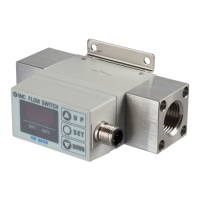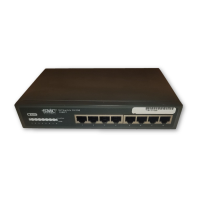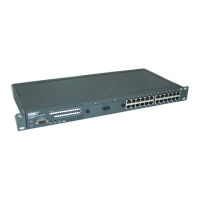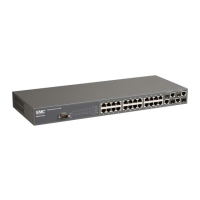Series PFA/PFW
Specific Product Precautions 2
Be sure to read before handling.
Refer to page 27 for safety instructions.
10. Provide a length of straight pipe before and
after a switch that is at least 8 times the pipe
diameter.
In cases where there is an abrupt reduction in the size of piping
or restriction due to a valve, etc., on the upstream side, the pres-
sure distribution in the piping changes, and accurate measure-
ment becomes impossible. Therefore, measures such as these
should be implemented on the downstream side of the switch.
[When used for water]
11. Never mount a switch in a place that will be
used as a scaffold during piping work.
Damage may occur if subjected to an excessive load. Especially
when the switch supports piping, do not apply a load of 15N⋅m or
more to the metal part of the switch.
12. Provide a length of straight pipe before and
after a switch that is at least 8 times the pipe
diameter.
In cases where there is an abrupt reduction in the size of piping
or restriction due to a valve, etc., on the upstream side, the flow
velocity distribution in the piping is disturbed, and accurate mea-
surement becomes impossible. Therefore, measures such as
these should be implemented on the downstream side of the
switch.
Furthermore, when used with the downstream side open, use
caution as there is a danger that cavitation will easily occur.
Mounting Operating Environment
29
1. Confirm wire colors and terminal numbers
when wiring is performed.
Since incorrect wiring can lead to damage or failure of the switch
as well as malfunction, perform wiring after confirming wiring col-
ors and terminal numbers with the instruction manual.
2. Avoid repeatedly bending or stretching lead
wires.
Broken lead wires will result from repeatedly applying bending
stress or stretching force to the lead wires.
3. Confirm proper insulation of wiring.
Be certain that there is no faulty wiring insulation (contact with
other circuits, ground fault, improper insulation between terminals,
etc.). Damage may occur due to excess current flow into a switch.
4. Do not wire with power lines or high voltage
lines.
Wire separately from power lines or high voltage lines, avoiding
parallel wiring or wiring in the same conduit with these lines.
Control circuits containing switches may malfunction due to noise
from these other lines.
5. Do not allow short circuiting of loads.
If a load is short circuited, an overcurrent error will be displayed by
the switch. However, wiring should be performed carefully, as pro-
tection cannot be afforded against all miswiring errors (power sup-
ply polarity, etc.).
Wiring
1. Never use in an atmosphere of explosive
gases.
The construction of switches is not intended to prevent explosion.
Never use in an atmosphere with an explosive gas since this may
cause a serious explosion.
2. Mount switches in locations without vibra-
tion (98m/s² or less) or impact (490m/s² or
less).
3. The flow switches are not lightning surge
proof.
Although flow switches have the CE marking, they are not light-
ning surge proof. Protective measures against lightning surges
should be made on the equipment.
4. Avoid use in locations where water or oil,
etc., is splashed or sprayed.
Switches are dust proof and splash proof, but avoid use in loca-
tions where a large amount of water or oil is splashed or sprayed.
Especially, the remote type display unit is an open type, and use
in locations with water or oil splashes must be avoided.
[When used for air]
5. Observe the fluid and ambient temperature
ranges.
The fluid and ambient temperatures are 0 to 50°C. Since moisture
in the fluid can freeze when used at 5°C or below, causing dam-
age and malfunction of switches, consider measures to prevent
freezing. The installation of an air dryer is recommended to
remove drainage and moisture from circuits.
Furthermore, even though the ambient temperature range
remains within specifications, do not operate in locations where
there are abrupt temperature changes.
[When used for water]
6. Observe the fluid and ambient temperature
ranges.
The fluid and ambient temperatures are 0 to 50°C. Since the fluid
can freeze when used at 5°C or below, causing damage and mal-
function of switches, consider measures to prevent freezing.
Furthermore, even though the ambient temperature range
remains within specifications, do not operate in locations where
there are abrupt temperature changes.
Maintenance
1. Perform inspections regularly to confirm
normal operation.
It may otherwise not be possible to assure safety due to unex-
pected malfunction or misoperation, etc.
2. Use caution when using in an interlock cir-
cuit.
When used in an interlock circuit, provide multiple interlock circuits
as a precaution against failure, and also perform regular inspec-
tions to confirm normal operation.
3. Do not disassemble or modify the unit.
